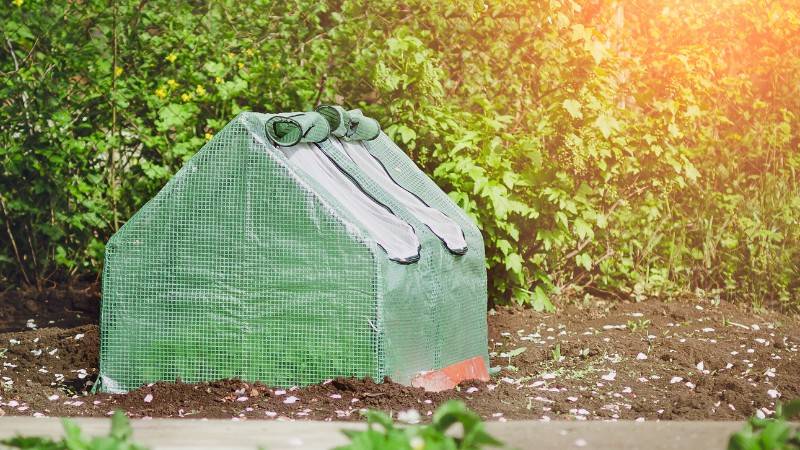If you want to grow your own food but don’t have a full garden, a mini greenhouse might be exactly what you need. These compact structures give you control over what you grow and how you grow it — without taking up much space.
They’re especially useful for small-space gardening, season extension, and keeping plants safe from pests and harsh weather. More importantly, they support a low-waste, low-impact lifestyle by making it easier to grow herbs, greens, and vegetables at home — no plastic packaging or long-haul transport needed.
In this guide, we’ll walk you through who benefits most from mini greenhouses and highlight brands that align with sustainable values — from material choices to ethical manufacturing. If you’re thinking about growing more of your own food and cutting back on environmental waste, this is a solid place to start.
What Is A Mini Greenhouse?
A mini greenhouse is an umbrella term for greenhouses that includes a wide variety of designs, from those that can fit a whole person who’s standing, to those that are small enough for tabletop use.
Mini greenhouses that are commercially sold are typically made of metal frames, have optional shelves, and have a PU or PE plastic cover that zips open on one side.
One main reason (to have a greenhouse) is to be able to ‘winter’ your plants. Even in the most temperate zone you risk frost and freeze on winter nights and a well-insulated greenhouse is ideal to save those favorite plants
— Kyle Barnette, Executive Director of the Charleston Horticultural Society
Most gardeners use them to start seedlings earlier or extend their growing season late into the fall. People also find them ideal for protecting their flowerbeds or individual plants against strong wind and pests.
Who Should Get a Mini Greenhouse?
A mini greenhouse isn’t just a gardening gadget — it’s a game-changer for anyone looking to live more sustainably, even with limited space. Whether you’re a seasoned grower or just dipping your toes into eco-living, there’s a mini greenhouse that fits your lifestyle.
Mini greenhouses are ideal for urban dwellers with balconies or small patios who want to grow herbs, leafy greens, or vegetables year-round. If you live in a colder climate and wish to extend your growing season, these compact structures can protect delicate plants from frost while maximizing sunlight and warmth.
They’re also perfect for beginners eager to experiment with seed starting or organic gardening without committing to a full-sized setup. Want to reduce your carbon footprint? Growing your own food cuts down on packaging waste, grocery trips, and the environmental impact of commercial farming.
Families looking for hands-on sustainability projects, compost enthusiasts, and eco-conscious DIYers will find that mini greenhouses support home composting, water-wise irrigation, and pesticide-free growing — all while fitting in a tight space.
If you want to grow more and waste less — whether for food, flowers, or fun — a mini greenhouse is your low-impact, high-reward companion.
What Can You Use a Mini Greenhouse For?
Mini greenhouses serve more than one purpose — they’re tools for better, more sustainable growing in small spaces. Whether you’re starting seeds early in spring, propagating plant cuttings, or keeping herbs alive through the winter, a mini greenhouse creates a controlled environment where plants thrive.
- Seed Starting: Jumpstart your growing season with better germination and protection from pests.
- Growing Edibles: Leafy greens, herbs, and even strawberries grow well in multi-tier setups or walk-in models — perfect for cutting down on store-bought produce.
- Overwintering Tender Plants: Keep succulents, ferns, or young veggies protected from cold snaps.
- Cutting Propagation: Create humidity-rich conditions for rooting stem cuttings more reliably.
Tabletop greenhouses are great for compact spaces and heat-loving plants, while vertical and walk-in models offer more space for experimentation.
That said, these smaller setups aren’t set-and-forget. Because heat and humidity build up fast, ventilation is key — open zippers, roll up flaps, or install a small solar fan if needed. Keeping the internal climate in check helps prevent mold, pests, and plant stress.
Each of these uses not only helps you grow more efficiently — they also support a low-impact, low-waste lifestyle.

Read More:
7 Mini Greenhouse Brands You Should Look for
1. Quictent: Greenhouse Gardening Made Accessible and Sustainable
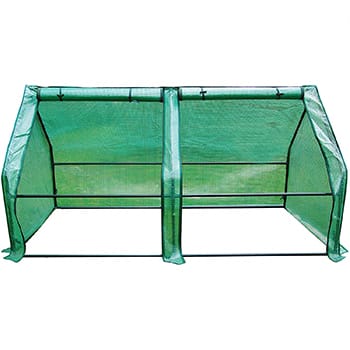
Quictent has earned its place as a go-to brand for budget-friendly, beginner-friendly mini greenhouses. But beyond affordability, what sets it apart in the green living space is its quiet commitment to helping people grow their own food, reduce waste, and live closer to nature — no matter the size of their yard or balcony.
At the heart of Quictent’s mission is accessibility. The brand makes greenhouse gardening available to anyone with even a sliver of outdoor space. By encouraging people to grow herbs, veggies, or flowers at home, Quictent supports a shift away from high-emission industrial agriculture and plastic-heavy store-bought produce.
Quictent’s greenhouses often feature durable PE covers — an eco-friendlier option compared to PVC — designed for long-term use and protection. Their sturdy frames promote reusability over throwaway construction, and many models come with zippered doors and roll-up windows for natural ventilation, reducing the need for powered temperature controls.
While not the loudest voice in the sustainability movement, Quictent takes practical steps toward low-impact manufacturing by using recyclable materials and minimizing excess packaging. Their greenhouses support water-wise gardening practices and make composting and vertical gardening easier for urban dwellers.
For eco-conscious consumers, Quictent is more than a greenhouse brand. It’s a nudge toward simpler living — where growing your own greens becomes not just possible, but effortless.
2. Outsunny: Blending Outdoor Living With Sustainable Growing
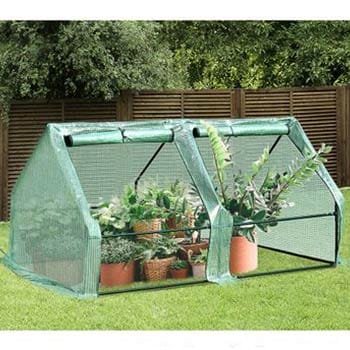
Outsunny, a sub-brand of Aosom, is known for making outdoor life more comfortable, functional, and fun. But when it comes to sustainability, their mini greenhouses offer more than just backyard charm — they invite a lifestyle of low-impact food growing and resource-conscious gardening.
The brand focuses on providing practical, ready-to-assemble greenhouses that help people grow their own herbs, greens, and seedlings. That simple act of growing at home reduces dependence on industrial farming and long-haul produce shipping — two of the biggest contributors to food-related carbon emissions.
Outsunny’s greenhouses often use powder-coated steel frames and PE covers — a longer-lasting, recyclable material with better environmental credentials than standard plastics. Their modular designs and zippered roll-up doors allow for energy-free airflow, helping users garden without the need for heating or lighting systems.
Though Outsunny doesn’t market itself as a green brand per se, many of its product choices reflect thoughtful design with sustainability in mind. The brand embraces multi-season durability and encourages reuse by offering replacement parts and modular upgrades. It’s about long-term usability, not fast-and-disposable.
For people seeking a balance between comfort, cost, and eco-awareness, Outsunny delivers tools for a more sustainable lifestyle — where homegrown food meets functional, outdoor design.
3. Ohuhu: Cultivating Creativity, One Sustainable Garden at a Time
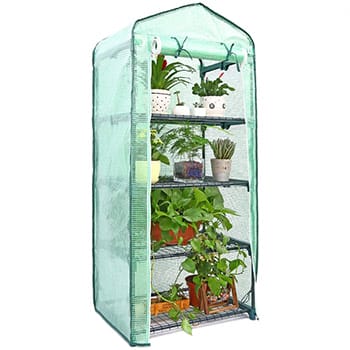
Ohuhu may be better known for its art supplies, but its venture into garden gear — including mini greenhouses — reflects a surprising and welcome shift toward sustainable DIY living. The brand champions affordability without sacrificing function, making it a strong ally for eco-minded gardeners just starting out.
Ohuhu’s mini greenhouses are designed for flexibility. Whether you’re nurturing seedlings on a balcony or protecting vegetables through seasonal shifts, their lightweight yet sturdy designs support year-round home gardening. And growing at home means fewer trips to the store, less plastic packaging, and a major reduction in food miles.
From a materials perspective, Ohuhu opts for steel frames and recyclable polyethylene covers — a practical balance between durability and environmental friendliness. These materials are made to last beyond a single season, helping users avoid the landfill-happy cycle of cheap, short-lived garden gear.
While Ohuhu doesn’t flaunt a big sustainability mission, its products enable the very behaviors that reduce environmental impact: growing your own food, reducing waste, and consuming more mindfully. The brand’s accessible pricing and simple design encourage everyday users to embrace small-scale gardening — without needing a backyard or a big budget.
In short, Ohuhu supports sustainability through action — helping people build greener habits, one mini greenhouse at a time.
4. Nova Microdermabrasion: Surprisingly Green in the Garden Game
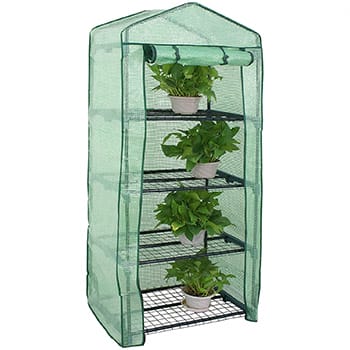
You might not expect a brand with “microdermabrasion” in its name to offer garden gear, but Nova Microdermabrasion has carved out a space in the mini greenhouse market — and done so with surprising eco-alignment. Their focus? Simple, functional designs that encourage sustainable habits at home.
Nova’s greenhouses are popular for their no-fuss assembly and compact size, making them a favorite among urban gardeners and beginners alike. By supporting seed starting, herb growing, and small-scale veggie cultivation, these greenhouses quietly promote self-reliant food production — a big win for lowering one’s environmental footprint.
The brand leans on powder-coated metal frames and PE plastic covers — materials chosen for their reusability and weather resistance. PE, in particular, is less toxic and more recyclable than other plastic covers, making it a more eco-conscious choice in affordable greenhouse design.
Though not a sustainability-focused brand on the surface, Nova’s greenhouse line encourages behavior that supports environmental responsibility: growing food locally, reducing packaging waste, and avoiding overconsumption. Their greenhouse models are reusable, seasonally adaptable, and perfect for composting or organic gardening setups.
For anyone curious about greener living but not ready to splurge, Nova Microdermabrasion delivers the tools — and the nudge — to start small, grow smart, and reduce waste right from your doorstep.
5. Home-Complete: Supporting Self-Sufficiency with Simplicity and Purpose
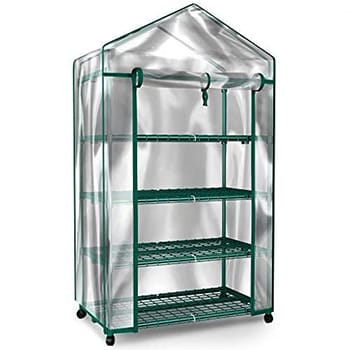
Home-Complete may not be a flashy name in sustainability circles, but its mini greenhouses quietly empower a powerful idea: self-sufficiency through simple, practical gardening. For eco-conscious consumers, that’s a meaningful step toward reducing waste and living more intentionally.
The brand’s greenhouse offerings focus on small-space growing — helping people nurture herbs, vegetables, and flowers right at home. Growing your own food means fewer trips to the store, less packaging waste, and a lower carbon footprint from transport and refrigeration.
Home-Complete uses rust-resistant steel frames and polyethylene covers, offering a solid balance between durability and environmental consideration. Their PE covers are not only reusable and weather-resistant but also more recyclable than many alternatives. Zippered doors and roll-up panels enhance natural ventilation, reducing the need for artificial heating or lighting.
While Home-Complete doesn’t heavily market its green mission, the utility of its greenhouses aligns naturally with sustainability goals. Their systems are ideal for compost-based gardening, organic soil use, and even upcycling projects like repurposing seed trays or containers.
Ultimately, Home-Complete helps eco-minded individuals start where it matters most — at home. It’s not about reinventing the wheel; it’s about making the tools for greener living easy to access, easy to use, and easy to sustain.
6. MACROUT: Small-Space Gardening with a Practical Eco Edge
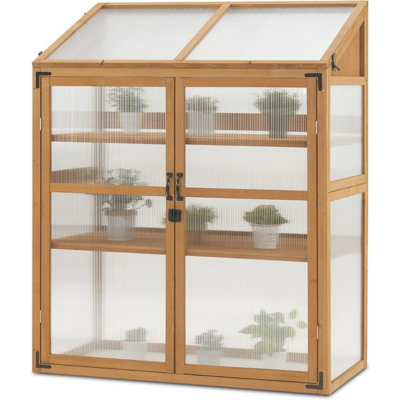
MACROUT is one of those under-the-radar brands quietly making a big difference for sustainable living. With its line of compact, functional mini greenhouses, the brand empowers apartment dwellers, patio gardeners, and small-yard growers to reduce their footprint one seedling at a time.
At its core, MACROUT supports low-impact living. Their greenhouses help users grow herbs, leafy greens, and vegetables close to home — slashing food miles and eliminating packaging waste from store-bought produce. It’s a hands-on way to make food systems more local and more sustainable.
MACROUT’s products often feature powder-coated steel frames and polyethylene covers — materials that balance resilience and recyclability. These structures are made to withstand multiple seasons, encouraging reuse instead of landfill-bound replacement. The roll-up windows and zippered enclosures support passive airflow, further lowering the need for electric fans or heaters.
While MACROUT doesn’t explicitly brand itself around sustainability, its products naturally fit into eco-conscious lifestyles. Their affordable pricing and no-frills designs lower the barrier for entry into home gardening, encouraging more people to participate in sustainable food production.
For green thumbs in tight spaces, MACROUT offers a solid, responsible starting point — turning balconies and backyards into mini ecosystems with big potential.
7. Pure Garden: Turning Everyday Spaces into Greener Places
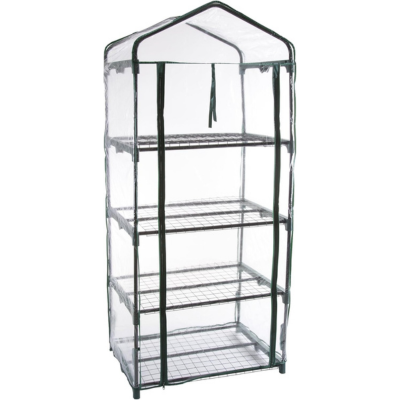
Pure Garden lives up to its name by helping everyday consumers bring nature back into their homes — and in doing so, it quietly supports a more sustainable way of living. With mini greenhouses designed for patios, porches, and small yards, the brand makes home gardening feel less like a hobby and more like a lifestyle shift.
What stands out about Pure Garden is its practical approach to growing. Their greenhouses make it easy for anyone to start small — whether you’re propagating seedlings, extending the life of your herbs, or growing produce year-round. That means less reliance on commercial food systems, less plastic packaging, and fewer trips to the grocery store.
On the materials front, Pure Garden opts for durable metal frames and polyethylene covers — a lightweight but more recyclable plastic compared to common alternatives. These greenhouses are built for reusability, with zippered doors and multi-tier shelves that support versatile gardening setups without the need for extra tech or tools.
While Pure Garden doesn’t wear its sustainability badge loudly, its products speak for themselves. By making green living accessible, the brand helps users embrace water-wise growing, compost integration, and even organic gardening with ease.
For anyone looking to align their home with eco-friendly values — without breaking the bank or the planet — Pure Garden offers a refreshingly straightforward path to greener growing.
Conclusion: Growing Green Starts Small — But Makes a Big Impact
A mini greenhouse may be small in size, but its benefits go far beyond your backyard. From slashing your food miles to embracing eco-friendly growing habits, these compact structures are perfect tools for anyone looking to live more sustainably — without needing acres of land or expensive systems.
With so many brands offering unique takes on sustainable greenhouse design, it’s easier than ever to find one that fits your space, your values, and your budget. Whether you’re a curious beginner or a seasoned grower ready to downsize your impact, a mini greenhouse can help you grow more, waste less, and live greener.
Looking for the best brands that prioritize ethical production, durable materials, and sustainable gardening? Keep reading — we’ve rounded up the top mini greenhouse brands that walk the green talk.
